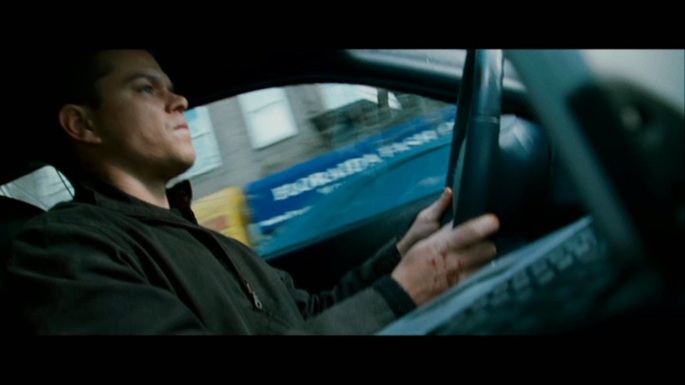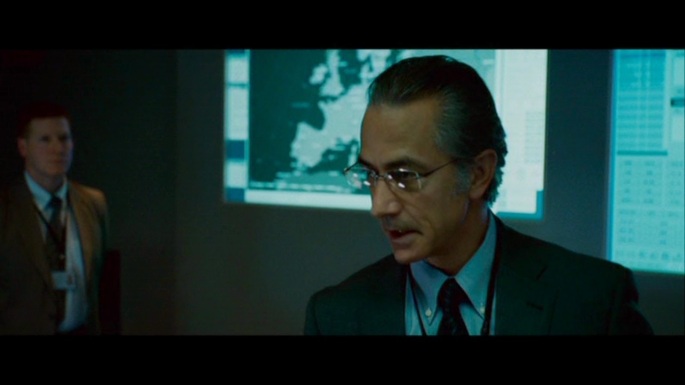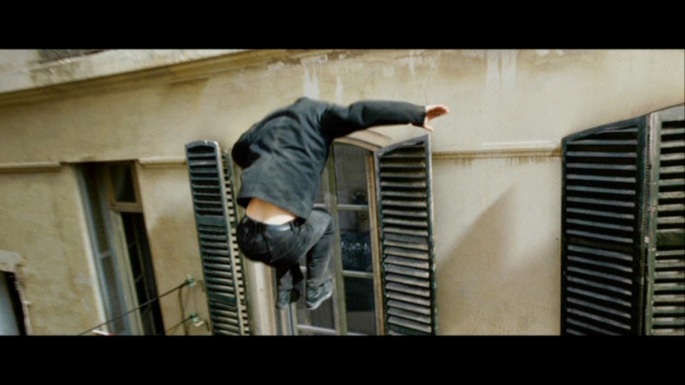
After two films with Jason Bourne (Matt Damon) on the defensive and on the run, The Bourne Ultimatum (2007) sees our hero going on the offensive and taking the fight to his handlers. Coming full circle not only thematically, but also on a production level – the film was born out of chaos as principal photography began without a completed screenplay – it managed to come out the other side with a coherent final product that endeared itself to both audiences and critics. Ultimatum not only avoids the dreaded third installment of a trilogy jinx (they are notoriously the weakest), but ends up being the strongest one of the series as Bourne gets some definitive answers to who he is and his past.
Ultimatum picks up right where The Bourne Supremacy (2004) left off with Bourne on the run in Moscow after being seriously injured in an exciting car chase with a fellow Treadstone assassin. Meanwhile, Simon Ross (Paddy Considine), an investigative reporter with The Guardian, a British newspaper, is working on a story about Bourne and a top-secret CIA operation known as Blackbriar. Naturally, the agency finds out and puts Ross under surveillance in the hopes that Bourne will contact him, which he does, at a busy London train station.
Bourne’s rendezvous with Ross amidst the hustle and bustle of the train station is a nice homage to the opening of Francis Ford Coppola’s The Conversation (1974) as the two men are heavily scrutinized by all kinds of CIA surveillance. There is a lot of fun to be had watching Bourne masterfully evade all their manpower and hi-tech equipment in a wonderfully intense and insanely choreographed sequence that successfully ratchets up the tension as the CIA closes in. However, before Bourne can get Ross to reveal his source, an extremely efficient Blackbriar assassin (Edgar Ramirez) kills the journalist and disappears like a ghost.
Fortunately, Bourne takes Ross’ notes and figures out that the source is located in Madrid. During the course of his investigation, Bourne is reunited with Nicky Parsons (Julia Stiles), a CIA operative sympathetic to his plight. Within the agency, the man in charge of Blackbriar, CIA Deputy Director Noah Vosen (David Strathairn) wants Bourne dead because he sees him as a dangerous liability while another agent, Pamela Landy (Joan Allen), wants to take him alive because she doesn’t agree with Vosen’s methods. This results in some wonderfully testy bickering between the two actors as they argue over what to do about Bourne. The rest of Ultimatum plays out as a brilliantly staged cat and mouse game with Bourne turning the tables on his handlers.
This time around, David Strathairn is the veteran character actor enlisted to play the CIA honcho tasked to find and eliminate Bourne. Like Chris Cooper (The Bourne Identity) and Brian Cox (The Bourne Supremacy) before him, he has the gravitas to play a take-charge authority figure and part of the enjoyment of this film is watching Bourne constantly thwart Vosen’s plans. In Ultimatum, Landy is a more sympathetic figure as she wants to capture Bourne alive (unlike Vosen). As the film progresses and she learns more about what the United States government did to Bourne and others in Treadstone, she realizes that she can no longer be complicit in the CIA’s illegal activities. Nicky Parsons also undergoes significant development as she ends up helping Bourne and turns out to be a key figure in his past.
Paul Greengrass, who also directed Supremacy, is back behind the camera bringing his trademark, no-nonsense pacing and visceral, hand-held camerawork to Ultimatum. The film’s action sequences are the epitome of edgy intensity as the fight scenes are quick and as brutal as a PG-13 rating will allow. They are realistically depicted – after all, guys as well trained as Bourne don’t waste any time and know exactly how to bring someone down as quickly and as efficiently as possible.
 Like with the other Bourne films, Ultimatum also has exciting chases, including the police pursuing Bourne over rooftops in Tangiers while he’s chasing an assassin going after Nicky, and a crazy car chase through the busy streets of New York City. Greengrass and his stunt people upped the ante on the chases, most notably the sequence in Tangiers, which starts off with scooters in the busy streets and then after a car bomb goes off, along rooftops on foot. Greengrass’ kinetic camerawork is taken to the next level as we literally follow Bourne leaping through the air from one building to another.
Like with the other Bourne films, Ultimatum also has exciting chases, including the police pursuing Bourne over rooftops in Tangiers while he’s chasing an assassin going after Nicky, and a crazy car chase through the busy streets of New York City. Greengrass and his stunt people upped the ante on the chases, most notably the sequence in Tangiers, which starts off with scooters in the busy streets and then after a car bomb goes off, along rooftops on foot. Greengrass’ kinetic camerawork is taken to the next level as we literally follow Bourne leaping through the air from one building to another.
The lo-tech versus hi-tech dichotomy is beautifully realized in all three Bourne films as symbolized in the way he kills the highly trained assassins sent to kill him. In The Bourne Identity (2002), it’s with a pen, in Supremacy it’s with a rolled up magazine and in Ultimatum it’s with a book. The films never make a big deal about it and even show how well Bourne can manipulate technology, but his best chance at survival is to MacGyver it and stay off the grid.
With the phenomenal success of The Bourne Supremacy, Universal Pictures persuaded screenwriter Tony Gilroy to write the first draft of The Bourne Ultimatum for a significant amount of money, but only under the conditions that he could leave after its completion and that he wouldn’t have to speak with director Paul Greengrass, who was also returning, and did not get along with the writer. According to Damon, “It’s really the studio’s fault for putting themselves in that position. I don’t blame Tony for taking a boatload of money and handing in what he handed in. It’s just that it was unreadable. This is a career-ender.”
After Gilroy left the project and a release date looming, Greengrass brought in four other writers including George Nolfi, Scott Z. Burns, and Tom Stoppard, the latter who said of his input: “Some of the themes are still mine—but I don’t think there’s a single word of mine in the film.” Amazingly, before the film’s release date, Gilroy arbitrated and lost to get sole credit. As a result, the filmmakers were writing the script as they were making the film over three continents in 140 shooting days. According to Damon, “There wasn’t a single day where we didn’t have new pages! The main issue was that a question was never answered: Why was Bourne here? … What Paul settled on was that it has to be a story about meeting his maker.”
The exciting chase through the streets of Tangiers was an homage to Gillo Pontecorvo’s Battle of Algiers (1966). It took 14 days to shoot with Bourne’s rooftop leap done by a stuntman jumping right behind Bourne while carrying a small, lightweight camera. According to second unit director and stunt coordinator Dan Bradley, he often allowed the stunt people to hold the cameras because “they’re not too freaked out about getting hit or sliding under something while holding a camera. Some of the best shots in Supremacy and Ultimatum are because the stunt guys were operating.” Once again, Greengrass applied an independent film aesthetic to a big studio movie budget or, as he put it, “one of the ways you do it is to try your luck and set the action in places where you can’t behave like a big movie … You’re forced to sort of be a bit like a student film and make it up as you go along, live on the land and shoot when people are around.”
 If Identity was about our hero escaping from his CIA handlers and Supremacy was about him figuring out why they are still after him, then Ultimatum is all about getting revenge on those responsible for messing up his life in the first place and figuring out, once and for all, his identity. What elevates Ultimatum (and the rest of the series) above, say, the Mission: Impossible movies, is that it is more than just an exciting thriller (although, it does work on that level). It is also has a sharp, political component in the form of a scathing critique of the CIA’s dirty little secrets. The series ultimately asks, what happens when a highly-trained and conditioned government operative questions what he does and why? How does he undo the programming that made him what he is and come to grips with what he’s done? This film answers these questions to a satisfying degree while also being very entertaining conclusion to the series.
If Identity was about our hero escaping from his CIA handlers and Supremacy was about him figuring out why they are still after him, then Ultimatum is all about getting revenge on those responsible for messing up his life in the first place and figuring out, once and for all, his identity. What elevates Ultimatum (and the rest of the series) above, say, the Mission: Impossible movies, is that it is more than just an exciting thriller (although, it does work on that level). It is also has a sharp, political component in the form of a scathing critique of the CIA’s dirty little secrets. The series ultimately asks, what happens when a highly-trained and conditioned government operative questions what he does and why? How does he undo the programming that made him what he is and come to grips with what he’s done? This film answers these questions to a satisfying degree while also being very entertaining conclusion to the series.